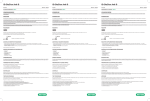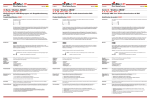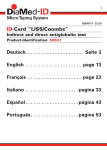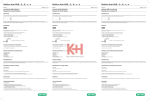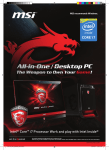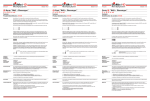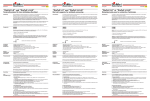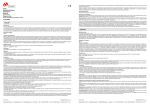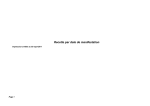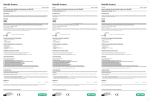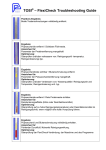Download DiaClon ABO/Rh for Newborns DVI+ DiaClon ABO/Rh for Newborns
Transcript
DiaClon ABO/Rh for Newborns DVI+ Deutsch A, B, AB, DVI+, ctl, DAT Bestimmung der ABO/Rh Blutgruppen bei Neugeborenen mit dem direkten Antiglobulintest (DAT) ID-Card B001028 03.12 DiaClon ABO/Rh for Newborns DVI+ English A, B, AB, DVI+, ctl, DAT Determination of the ABO/Rh blood groups with direct antiglobulin test (DAT) for newborns ID-Card B001028 03.12 DiaClon ABO/Rh for Newborns DVI+ Français A, B, AB, DVI+, ctl, DAT Détermination des groupes sanguins ABO/Rh pour nouveau-nés, avec le test direct à l‘antiglobuline (TDA) ID-Card B001028 03.12 Produkt-Identifikation: 50961 Product-Identification: 50961 Identification de produit : 50961 Einleitung Introduction Introduction Anti-A-, Anti-B- und Anti-AB-Testseren werden für die Bestimmung der A/B-Antigene benötigt. Da die Antigene A und B bei der Geburt noch nicht vollständig entwickelt sind, können die Reaktionen schwächer sein als mit Erwachsenen-Bluten. Untergruppen können oft nicht bestimmt werden. Anti-A, anti-B and anti-AB test sera are necessary to detect the presence or absence of A/B antigens on human red cells. Since A and B antigens are not fully developed at birth, weaker reactions may occur with red cells of newborns than of adults and subgroups often cannot be identified. Das Serum von Erwachsenen enthält Antikörper gegen die auf Erythrozyten nicht vorhandenen Antigene A und B. Diese Antikörper treten nach den ersten 4 bis 6 Lebensmonaten auf. Entsprechend kann die Serumgegenprobe bei Neugeborenen nicht durchgeführt werden. Es ist deshalb angezeigt, die beim Neugeborenen bestimmte Blutgruppe nach 2 bis 4 Jahren zu bestätigen, wenn die Antigene A und B voll entwickelt sind. The serum of adults contains antibodies directed against the A and B antigens absent from their own red cells. Both antibodies appear after the first 4 to 6 months of life. As a result, reverse grouping is not usually undertaken on newborn blood samples. Confirmation of the newborn’s blood group is indicated when the A and B antigen expression is fully developed (2–4 years). Les sérums-tests anti-A, anti-B et anti-AB sont nécessaires pour détecter la présence ou l’absence des antigènes A/B sur les hématies humains. A la naissance, les antigènes A et B ne sont pas complètement développés ; des réactions affaiblies peuvent donc se produire avec le sang des nouveau-nés et, donc, les sous-groupes ne peuvent être toujours identifiés. Das Antigen D wie auch schwaches D ist bei der Geburt vollständig entwickelt. Bei Rh-negativen Müttern ist die Bestimmung des RhD und des schwachen D beim Neugeborenen unerlässlich. The D antigen as well as weak D is fully developed at birth. The determination of the RhD status of the newborn’s blood group is important if the mother is RhD negative. Die Durchführung des direkten Antiglobulintests (DAT) bei Neugeborenen ist Routinesache, da es wichtig ist festzustellen, ob die Erythrozyten des Neugeborenen mit Antikörpern in utero beladen sind. A direct antiglobulin test (DAT) on newborn blood samples has become a standard procedure, since it is of importance to know if the newborn’s red cells have been coated with maternal antibodies in-utero. Reagenzien Reagents Réactifs ID-Karte ˝DiaClon ABO/Rh for Newborns DVI+˝ enthält monoklonales Anti-A [Zellinie LM 297/628 (LA-2)], Anti-B [Zellinie LM 306/686 (LB-2)], Anti-AB [Zellinien ES131 (ES-15) + Birma-1 + ES-4] und Anti-D (Zellinien ESD-1M + 175-2) in der Gelmatrix. Das Mikroröhrchen (ctl) dient zur negativen Kontrolle. Das Anti-Humanglobulinserum ist eine Mischung aus Kaninchen-Anti-IgG und monoklonalem Anti-C3d (Zellinie C139-9). ID-Card ˝DiaClon ABO/Rh for Newborns DVI+˝ contains monoclonal anti-A [cell line LM 297/628 (LA-2)], anti-B [cell line LM 306/686 (LB-2)], anti-AB [cell lines ES131 (ES-15) + Birma-1 + ES-4] and anti-D (cell lines ESD-1M + 175-2), within the gel matrix. The microtube (ctl) is the negative control. The anti-human globulin serum is a blend of rabbit anti-IgG and monoclonal anti-C3d (cell line C139-9). Carte-ID ˝DiaClon ABO/Rh for Newborns DVI+˝ contient de l’anti-A monoclonal [lignée cellulaire LM 297/628 (LA-2)], anti-B [lignée cellulaire LM 306/686 (LB2)], anti-AB [lignées cellulaires ES131 (ES-15) + Birma-1 + ES-4] et anti-D [lignées cellulaires ESD-1M + 175-2] inclus dans le gel. Le microtube (ctl) est le contrôle négatif. L’antiglobuline humaine est un mélange d’anti-IgG de lapin et d’anti-C3d monoclonal (lignée cellulaire C139-9). Konservierungsmittel: < 0,1% NaN3. Preservative: < 0.1% NaN3. Conservateurs : < 0,1% NaN3. Achtung: Alle Reagenzien sollten als potentiell infektiös gehandhabt werden. Caution: All reagents should be treated as potentially infectious. Attention : Tout réactif doit être considéré comme potentiellement infectieux. Ne pas stocker à proximité d’une source de chaleur, d’une climatisation ou une sortie de ventilation. Stabilité : voir la date de péremption sur l’étiquette. Nicht in der Nähe von Hitzequellen, Klimaanlagen oder Lüftungsausgängen lagern. Stabilität: siehe Verfallsdatum auf dem Etikett. Do not store near any heat, air conditioning sources or ventilation outlets. Stability: see expiry date on label. Le sérum des adultes contient des anticorps anti-A et anti-B lorsque les antigènes correspondants sont absents sur les hématies. Ces anticorps n’apparaissent que 4 à 6 mois après la naissance. Par conséquent, l’épreuve sérique (test de Simonin) n’est habituellement pas réalisé avec le sérum du nouveau-né. Il est donc recommandé de confirmer le groupe ABO du nouveau-né quand l’expression des antigènes A et B est complètement développée (dès l’âge de 2 à 4 ans). Les antigènes RhD et D faible sont entièrement développés à la naissance. La détermination du RhD et D faible est indispensable chez le nouveau-né si la mère est RhD négatif. Le test direct à l’antiglobuline (TDA) avec les hématies du nouveau-né est une procédure établie, puisqu’il est important de savoir si les hématies sont sensibilisées par les anticorps maternels in utéro. Zusätzlich benötigte Reagenzien Additional reagents required Réactifs supplémentaires nécessaires ID-Diluent 2: Modifiziertes LISS zur Herstellung der Erythrozytensuspensionen. ID-Diluent 2: modified LISS for red cell suspensions. ID-Diluent 2 : LISS modifié pour suspensions d’hématies. (siehe diesbezügliche Packungsbeilage) (see related package insert) (voir mode d’emploi correspondant) Weitere erforderliche Materialien Further materials required Matériaux supplémentaires nécessaires • • • • • • • • • • • • • • • • • • ID-Dispenser ID-Pipetor ID-Tips (Pipetor-Spitzen) Suspensionsröhrchen ID-Arbeitsplatz ID-Zentrifuge 6, 12 oder 24 ID-Dispenser ID-Pipetor ID-Tips (pipetor tips) Tubes for suspensions ID-Working table ID-Centrifuge 6, 12 or 24 ID-Dispenser ID-Pipetor ID-Tips (cônes pour pipette) Tubes pour suspensions ID-Table de travail ID-Centrifuge 6, 12 ou 24 Probenmaterial Sample material échantillons Blutproben werden nach allgemeingültigen Entnahmeverfahren gewonnen. Nabelschnurproben oder Fersenpunktate können verwendet werden. Die Erythrozyten müssen vor Gebrauch nicht gewaschen werden (siehe ̋Anmerkungen˝). Wenn Nabelschnurproben verwendet werden, sollte darauf geachtet werden, eine Kontamination mit Wharton-Sulze zu vermeiden. Draw blood samples using acceptable phlebotomy techniques. Cord or heel prick samples may be used. It is normally not necessary to wash the cells before use (see ̋Remarks˝). Where cord samples are used, care must be taken to avoid contamination with Wharton’s jelly. Prélever les échantillons selon des techniques de phlébotomie correctes. Sang de cordon ombilical ou sang capillaire prélevé au talon peuvent être utilisés. Normalement il n’est pas nécessaire de laver les hématies avant utilisation (voir ̋Remarques˝). Si du sang de cordon est utilisé, éviter la contamination par la gelée de Wharton. Die Probengewinnung sollte in Citrat, EDTA oder CPD-A erfolgen. Um verlässliche Resultate zu erhalten, empfiehlt sich die Verwendung von frisch entnommenem Blut. Preferably, blood samples should be drawn into Citrate, EDTA or CPD-A. For reliable results, use of freshly collected blood is indicated. Les échantillons doivent être prélevés en citrate, EDTA ou CPD-A. Pour des résultats fiables, utiliser du sang frais. Vorbereitung der Blutprobe Preparation of blood sample Préparation de l’échantillon de sang Eine 0,8%ige Erythrozytensuspension in ID-Diluent 2 wie folgt herstellen: Prepare a 0.8% red cell suspension in ID-Diluent 2 as follows: Préparer une suspension d’hématies à 0,8% en ID-Diluent 2, comme suit : Diluent vor Gebrauch auf Raumtemperatur bringen. Allow the diluent to reach room temperature before use. Ramener le diluant à température ambiante avant utilisation. 1. 1,0 ml ID-Diluent 2 in ein sauberes Röhrchen pipettieren. 2. 10 µl Erythrozytenkonzentrat oder 20 µl Vollblut hinzugeben; leicht mischen. 1. Dispense 1.0 ml of ID-Diluent 2 into a clean tube. 2. Add 10 µl of packed red cells or 20 µl of whole blood, mix gently. 1. Distribuer 1,0 ml d’ID-Diluent 2 dans un tube propre. 2. Ajouter 10 µl de culot d’hématies ou 20 µl de sang total, mélanger doucement. Die Erythrozytensuspension kann sofort verwendet werden. The cell suspension may be used immediately. La suspension d’hématies peut être utilisée immédiatement. Kontrollen Controls Contrôles Bekannte Antigen-positive und -negative Erythrozyten sollten in Übereinstimmung mit den gültigen Richtlinien zur Qualitätssicherung mitgeführt werden. Known positive and negative samples should be included in accordance with the relevant guidelines of quality assurance. Des échantillons positifs et négatifs connus devront être inclus en concordance avec les réglementations régissant l’assurance qualité. TestduRchführung Test procedure Méthode Keine ID-Karten benutzen mit Anzeichen von Austrocknung, Luftblasen, beschädigter Versiegelung oder Tropfen des Gels bzw. des Überstandes im oberen Teil der Mikrokammer oder auf der Unterseite der Versiegelung. Do not use ID-Cards which show signs of drying, have bubbles, damaged seals, drops of gel or supernatant in the upper part of the microtubes or on the underside of the aluminium foil. Ne pas utiliser les cartes-ID présentant des signes de desséchement, des bulles d’air dans le gel, un système de fermeture endommagé, des goutelettes de gel ou de surnageant sur les parois supérieures des microtubes ou sur la face interne de la languette d’aluminium. 1.Die ID-Karte mit den Patienten- oder Spenderdaten beschriften. 2. Aluminiumfolie von den benötigten Mikroröhrchen in aufrechter Kartenposition entfernen. 3.50 µl der Erythrozytensuspension in alle 6 Mikroröhrchen der ID-Karte pipettieren. 4.ID-Karte 10 Minuten in der ID-Zentrifuge zentrifugieren. 5.Reaktionen ablesen und aufzeichnen. 1. Identify the ID-Card with the unique patient or donor number/details as appropriate. 2.Remove the aluminium foil from as many microtubes as required by holding the ID-Card in the upright position. 3.Pipette 50 µl of the red cell suspension to all 6 microtubes of the ID-Card. 4.Centrifuge the ID-Cards for 10 minutes in the ID-Centrifuge. 5.Read and record the results. 1.Identifier la carte-ID avec le numéro d’enregistrement unique du patient ou donneur / toutes identifications pertinentes. 2.Décoller la languette d’aluminium des microtubes nécessaires en tenant la carte-ID en position verticale. 3.Pipetter 50 µl de la suspension d’hématies à tous les microtubes de la carte-ID. 4.Centrifuger la carte-ID 10 minutes dans l’ID-Centrifuge. 5.Lire et noter les réactions. DiaClon ABO/Rh for Newborns DVI+ ID-Card Français B001028 03.12 DiaClon ABO/Rh for Newborns DVI+ ID-Card English B001028 03.12 DiaClon ABO/Rh for Newborns DVI+ Deutsch B001028 03.12 Interprétation des résultats Interpretation of the results Interpretation der Ergebnisse A)Principe [2] A)Principle [2] A)Prinzip [2] Positif :Hématies agglutinées formant une ligne rouge à la surface du gel ou des agglutinats dispersés dans le gel. Positive:Agglutinated cells forming a red line on the surface of the gel or agglutinates dispersed in the gel. Positiv:Agglutinierte Erythrozyten bilden eine rote Linie auf dem Gel oder sind im Gel verteilt. Négatif :Hématies en culot compact au fond du microtube. Negative:Compact button of cells on the bottom of the microtube. Negativ:Kompaktes Erythrozytensediment am Boden des Mikroröhrchens. B)Réactions des groupes sanguins ABO Anti-A B)Reactions for blood groups ABO Anti-B Anti-AB Groupe sanguin Anti-A ID-Card B)Reaktionen der ABO Blutgruppen Anti-B Anti-AB Blood group Anti-A Anti-B Anti-AB Blutgruppe + à ++++ négatif + à ++++ A + to ++++ negative + to ++++ A + bis ++++ negativ + bis ++++ A négatif + à ++++ + à ++++ B negative + to ++++ + to ++++ B negativ + bis ++++ + bis ++++ B + à ++++ + à ++++ + à ++++ AB + to ++++ + to ++++ + to ++++ AB + bis ++++ + bis ++++ + bis ++++ AB négatif négatif négatif O negative negative negative O negativ negativ negativ O En présence d’antigènes ayant une expression faible ou très faible la réaction peut être négative. L’anti-B monoclonal ne réagit pas avec les antigènes B acquis. In the presence of weak or very weakly expressed antigens the reaction can be negative. The anti-B of monoclonal origin does not react with the acquired B antigen. Bei Vorhandensein von schwach bis sehr schwach exprimierten Antigenen kann eine negative Reaktion vorliegen. Das Anti-B monoklonalen Ursprungs reagiert nicht mit dem erworbenen B-Antigen. Important : Le microtube ctl doit montrer une réaction négative. Si le ctl est positif, la détermination ABO ne peut être validée. Répéter le test comme décrit sour ˝Remarques 1.˝. Important: The microtube ctl must show a negative reaction. If the ctl is positive, the ABO determination is not valid. Repeat the test as described under ˝Remarks 1.˝. Wichtiger Hinweis: Das Mikroröhrchen ctl muss eine negative Reaktion aufweisen. Falls ctl positiv ist, ist die Blutgruppenbestimmung ungültig. Der Test ist wie unter ̋Anmerkungen 1.˝ beschrieben zu wiederholen. C)Réactions pour RhD C)Reactions for RhD C)Reaktionen für RhD +++ à ++++ ± à ++* négatif +++ to ++++ ± to ++* negative +++ bis ++++ ± bis ++* negativ RhD positif RhD faible positif RhD négatif RhD positive RhD weak positive RhD negative RhD positiv RhD schwach positiv RhD negativ * ±, des traces ou des réactions faibles seront sujettes à des investigations complémentaires afin de différencier un D faible d’un D partiel, selon le type d’échantillon analysé. * ±, trace or weak reactions should be subject to further investigations to distinguish between weak and partial D types as appropriate for the category of sample being tested. * Bei schwachen, ± oder Spuren von Reaktionen sollten weiterführende Untersuchungen zur Unterscheidung zwischen schwachen und Kategorien der partiellen D Typen durchgeführt werden. Le sérum test Anti-D a été sélectionné également pour détecter les variants DVI. Quelques antigènes variants DVI peuvent donner des réactions très faibles. The anti-D test sera were selected so as to react with DVI variants. Some DVI variants can give very weak reaction. Das Anti-D Testserum wurde so ausgewählt, dass es mit DVI-Varianten reagiert, jedoch können manche DVI-Varianten schwach positive Reaktionen zeigen. Important : Le microtube ctl doit montrer une réaction négative. Si le ctl est positif, la détermination RhD ne peut être validée. Répéter le test comme décrit sous ˝Remarques 1.˝. Important: The microtube ctl must show a negative reaction. If the ctl is positive, the RhD determination is not valid. Repeat the test as described under ˝Remarks 1.˝. Wichtiger Hinweis: Das Mikroröhrchen ctl muss eine negative Reaktion aufweisen. Falls ctl positiv ist, ist die RhD-Bestimmung ungültig. Der Test ist wie unter ̋Anmerkungen 1.˝ beschrieben zu wiederholen. D)Réactions pour le test direct à l’antiglobuline (TDA) D)Reactions for the direct antiglobulin test (DAT) D)Reaktionen im direkten Antiglobulintest (DAT) Une réaction négative indique l’absence d’anticorps détectables sur les hématies du nouveau-né. A negative reaction indicates the absence of detectable antibodies on the newborn’s red cells. Eine negative Reaktion weist auf Abwesenheit nachweisbarer Antikörper auf den Erythrozyten des Neugeborenen hin. Une réaction positive (± à ++++) indique que les hématies du nouveau-né sont sensibilisées (anticorps fixés sur les hématies). A positive reaction (± to ++++) indicates that the newborn’s red cells are sensitized (red cells coated with antibodies). Eine positive Reaktion (± bis ++++) bedeutet, dass die Erythrozyten des Neugeborenen sensibilisiert sind (an der Oberfläche der Erythrozyten gebundene Antikörper). remarques remarks anmerkungen 1.Le microtube (ctl) doit toujours montrer une réaction négative. Si le contrôle négatif est positif, procéder comme suit : • Laver d’abord les hématies en solution isotonique (ou en ID-Diluent 2) avant de préparer la suspension d’hématies à 0,8%. • Procéder ensuite comme décrit dans les paragraphes : ˝Préparation de l’échantillon de sang˝ et ˝Méthode˝. 1.The negative control (ctl) must always show a negative reaction. If the negative ctl is positive, proceed as follows: • Wash the red cells first with isotonic saline solution (or ID-Diluent 2) before preparing the 0.8% cell suspension. • Then proceed as under ˝Preparation of blood sample˝ and ˝Test procedure˝. 1.Die negative Kontrolle (ctl) muss immer eine negative Reaktion zeigen. Falls sie positiv ist, wie folgt fortfahren: • Die Erythrozyten zuerst mit isotonischer Kochsalzlösung (oder ID-Diluent 2) waschen, bevor die 0,8%ige Erythrozytensuspension zubereitet wird. • Fortfahren wie unter ˝Vorbereitung der Blutprobe˝ und ˝Testdurchführung˝ beschrieben. 2.Si le contrôle négatif (ctl) reste positif, l’interprétation des groupes ABO et RhD ne peut être assurée et des investigations supplémentaires sont nécessaires. 2.If the negative control remains positive, safe interpretation of the ABO and RhD groups cannot be made and further investigation is required. 2.Bleibt die negative Kontrolle ctl weiterhin positiv, kann keine sichere Interpretation der Blutgruppen ABO und RhD gemacht werden, weitere Untersuchungen sind notwendig. Limites Limitations Einschränkungen a)Les cartes-ID présentant des bulles d’air dans le gel ou des goutelettes dans la partie supérieure des microtubes ou sur la languette métallique doivent être centrifugées avant utilisation. b)Des contaminations, bactériennes ou autres, du matériel utilisé peuvent provoquer des résultats faussement positifs ou faussement négatifs. c)Des résidus de fibrine dans la suspension d’hématies peuvent emprisonner quelques cellules non agglutinées, formant ainsi une fine ligne rose à la surface du gel, alors que la plupart des hématies sont dans le fond du microtube aprés centrifugation. d)L’observation stricte des méthodes et l’emploi de l’équipement recommandé sont essentiels. L’équipement doit être régulièrement contrôlé selon les procédures des GLP. e)L’utilisation de diluants autres que l’ID-Diluent 2 peut modifier les résultats. f)Des suspensions d’hématies trop concentrées ou trop diluées peuvent provoquer des résultats aberrants. a)ID-Cards which show air bubbles in the gel or drops in the upper part of the microtubes and/or the seal, must be centrifuged before use. b)Bacterial or other contamination of materials used can cause false positive or false negative results. c)Fibrin residues in the red cell suspension may trap non-agglutinated cells presenting a fine pink line on top of the gel while most of the cells are on the bottom of the microtube after centrifugation. d)Strict adherence to the procedures and recommended equipment is essential. The equipment should be checked regularly according to GLP procedures. e)Use of suspension solutions other than ID-Diluent 2 may modify the reactions. f)Too heavy or too weak red cell suspensions can cause aberrant results. a)ID-Karten mit Luftblasen im Gel oder Tropfen im oberen Bereich der Mikrokammern und/oder Versiegelung müssen vor Gebrauch zentrifugiert werden. b)Bakterielle oder andere Kontaminationen des verwendeten Materials können falsch positive oder falsch negative Ergebnisse verursachen. c)Fibrinreste in der Erythrozytensuspension können nicht-agglutinierte Erythrozyten verkleben, die sich als feine rosa Linie auf der Geloberfläche darstellen, während die meisten Erythrozyten nach Zentrifugation am Boden der Mikroröhrchen ein kompaktes Sediment bilden. d)Striktes Befolgen der Anleitungen und Verwendung des erforderlichen Arbeitmaterials sind unerlässlich. Das Arbeitsmaterial sollte regelmässig entsprechend der GLP-Richtlinien überprüft werden. e)Der Gebrauch anderer Lösungen als ID-Diluent 2 für die Erythrozytensuspensionen kann die Reaktionen beeinflussen. f)Zu starke oder zu schwache Erythrozytensuspensionen können abnormale Reaktionen hervorrufen. Bibliographie Bibliography Literatur 1.Mollison, P.L., Engelfriet, C.P. and Contreras, M.: Blood Transfusion in Clinical Medicine, 10th ed. 1997; Blackwell Scientific Publications, Oxford. 2.American Association of Blood Banks: Technical Manual; 11th ed. 1993. 3.Lapierre, Y., Rigal, D., Adam, J. et al.: The gel test; A new way to detect red cell antigen-antibody reactions. Transfusion 1990; 30: 109–113. 1.Mollison, P.L., Engelfriet, C.P. and Contreras, M.: Blood Transfusion in Clinical Medicine, 10th ed. 1997; Blackwell Scientific Publications, Oxford. 2.American Association of Blood Banks: Technical Manual; 11th ed. 1993. 3.Lapierre, Y., Rigal, D., Adam, J. et al.: The gel test; A new way to detect red cell antigen-antibody reactions. Transfusion 1990; 30: 109–113. 1.Mollison, P.L., Engelfriet, C.P. and Contreras, M.: Blood Transfusion in Clinical Medicine, 10th ed. 1997; Blackwell Scientific Publications, Oxford. 2.American Association of Blood Banks: Technical Manual; 11th ed. 1993. 3.Lapierre, Y., Rigal, D., Adam, J. et al.: The gel test; A new way to detect red cell antigen-antibody reactions. Transfusion 1990; 30: 109–113. Produits Products Carte-ID ˝DiaClon ABO/Rh for Newborns DVI+˝ 4 24 60 112 x x x x 12 . . . . . . . . . . . . . . . 12 . . . . . . . . . . . . . . . 12 . . . . . . . . . . . . . . . 12 . . . . . . . . . . . . . . . REF REF REF REF 001047 001048 001049 001050 Ces produits sont garantis quant à leurs propriétés et qualités stipulées sur l’étiquette et dans le mode opératoire. Le fabricant décline toute responsabilité pour les cas où ces produits seraient employés ou vendus à d’autres usages. DiaMed GmbH 1785 Cressier FR Suisse 0123 Produkte ID-Card ˝DiaClon ABO/Rh for Newborns DVI+˝ 4 24 60 112 x x x x 12 . . . . . . . . . . . . . . . 12 . . . . . . . . . . . . . . . 12 . . . . . . . . . . . . . . . 12 . . . . . . . . . . . . . . . REF REF REF REF 001047 001048 001049 001050 These products are guaranteed to perform as described on the label and in the instruction sheet. The manufacturer declines all responsibility arising out of the use or sale of these products in any way or for any purpose other than those described therein. DiaMed GmbH 1785 Cressier FR Switzerland 0123 ID-Karte ˝DiaClon ABO/Rh for Newborns DVI+˝ 4 24 60 112 x x x x 12 . . . . . . . . . . . . . . . 12 . . . . . . . . . . . . . . . 12 . . . . . . . . . . . . . . . 12 . . . . . . . . . . . . . . . REF REF REF REF Für diese Produkte wird nur Garantie übernommen, wenn sie gemäss den Angaben auf dem Etikett und der Anwendungsvorschrift verwendet werden. Jegliche Verantwortung wird ausdrücklich abgelehnt, wenn das Präparat für andere Zwecke gebraucht oder verkauft wird. DiaMed GmbH 1785 Cressier FR Schweiz 0123 001047 001048 001049 001050 DiaClon ABO/Rh for Newborns DVI+ Italiano A, B, AB, DVI+, ctl, DAT Determinazione del gruppo sanguigno ABO/Rh nei neonati con test diretto all‘antiglobulina (TAD) ID-Card B001028 03.12 DiaClon ABO/Rh for Newborns DVI+ Español A, B, AB, DVI+, ctl, DAT Determinacíon de los grupos sanguìneos ABO/Rh en recién nacidos con la prueba de antiglobulina directa (PAD) ID-Card B001028 03.12 DiaClon ABO/Rh for Newborns DVI+ Português A, B, AB, DVI+, ctl, DAT Determinação dos grupos sanguíneos ABO/Rh em recém-nascidos com o teste de antiglobulina directo (TAD) ID-Card B001028 03.12 Identificazione prodotto: 50961 Identificación del producto: 50961 Identificação do Produto: 50961 Introduzione Introducción Introdução I sieri anti-A, anti-B e anti-AB servono per la determinazione degli antigeni A/B. Poiché gli antigeni A e B non sono ancora completamente sviluppati alla nascita, le reazioni con i corrispondenti antiseri possono essere più deboli con emazie di neonato che con emazie di adulto. Spesso i sottogruppi deboli non riescono ad essere evidenziati. Los antiseros anti-A, anti-B y anti-AB son necesarios para la determinación de los antígenos A/B en los hematíes humanos. Al nacer los antígenos A y B no están totalmente desarrollados, las reacciones pueden ser más débiles que con la sangre de adultos y a menudo no pueden identificarse los sub-grupos. Os soros-teste Anti-A, Anti-B e Anti-AB são necessários para a determinação dos antigénios A/B. Uma vez que os antigénios A e B ainda não estão totalmente desenvolvidos na altura do nascimento, as reacções podem ser menos acentuadas que no sangue de adultos. Os subgrupos não podem ser determinados. Il siero degli adulti contiene anticorpi contro gli antigeni A e B non presenti sugli eritrociti. Questi anticorpi compaiono dopo i 4–6 mesi di vita. Di conseguenza nei neonati non è possibile eseguire la controprova sierologica. Pertanto è opportuno confermare il gruppo sanguigno determinato nel neonato dopo 2–4 anni, quando gli antigeni A e B si saranno completamente sviluppati. Sia l’antigene D che il D debole sono invece completamente sviluppati alla nascita. È importante la determinazione del fattore Rh-D in neonati di madri Rh-D negative. L’esecuzione del test diretto all’antiglobulina (TAD) nei neonati è una procedura di routine, dato che è importante accertare se gli eritrociti del neonato sono stati sensibilizzati ˝in-utero˝ da anticorpi materni. El suero de los adultos contiene anticuerpos contra los antígenos A y B ausentes en sus propios hematíes. Estos anticuerpos aparecen después de los primeros 4 ó 6 meses de vida. Por consiguiente, el grupo inverso o grupo séricono se debe realizar en el recién nacido. Por esto, está indicado confirmar la determinación de grupo sanguíneo de los recién nacidos a los 2 ó 4 años, cuando los antígenos A y B están totalmente desarrollados. El antígeno D, igual que el D débil están totalmente desarrollados al nacer. En las madres Rh negativas es indispensable determinar el antígeno D y D débil del recién nacido. La realización de la prueba de antiglobulina directa (PAD) en recién nacidos es una determinatión de rutina ya que es importante saber si los hematíes de los recién nacidos están sensibilizados con anticuerpos maternos inntra utero. O soro de adultos contém anticorpos contra os antigénios A e B não existentes nos eritrócitos. Estes anticorpos surgem apenas depois dos primeiros 4 a 6 meses de vida. Por conseguinte, a prova reversa com soro não pode ser realizada nos recém-nascidos. Por isso recomenda-se confirmar o grupo sanguíneo determinado no recém-nascido, passado 2 a 4 anos, quando os antigénios A e B estiverem totalmente desenvolvidos. O antigénio D (e também o D fraco está totalmente desenvolvido aquando do nascimento. Quando as mães são Rh-negativas a determinação do RhD e do D fraco no recém-nascido é indispensável. A realização do teste de antiglobulina directo (TAD) nos recém-nascidos faz parte da rotina, uma vez que é importante verificar se os eritrócitos do recémnascido foram imunizados com anticorpos ˝in utero˝. Reagenti Reactivos Reagentes La schedina ID ˝DiaClon ABO/Rh for Newborns DVI+˝ contiene nella matrice del gel i sieri anti-A monoclonale [linee cellulari LM 297/628 (LA-2), anti-B [linea cellulare LM 306/686 (LB-2)], anti-AB [linee cellulari ES131 (ES-15) + Birma-1 + ES-4], anti-D (linee cellulari ESD-1M + 175-2). La microprovetta (ctl) serve da controllo negativo. L’antiglobulina umana è una miscela di anti-IgG di coniglio e anti-C3d monoclonale (linea cellulare C139-9). La tarjeta-ID ˝DiaClon ABO/Rh for Newborns DVI+˝ contiene anti-A monoclonal [líneas celulares LM 297/628 (LA-2), anti-B [línea celular LM 306/686 (LB-2)], anti-AB [líneas celulares ES131 (ES-15) + Birma-1 + ES-4], anti-D (líneas celulares ESD-1M + 175-2), en la matriz gel. El micro-tubo (ctl) es el control negativo. El suero de antiglobulina humana es una mezcla de anti-IgG (conejo) y anti-C3d monoclonal (línea celular C139-9). O Card ID ˝DiaClon ABO/Rh for Newborns DVI+˝ contém Anti-A [Clone LM 297/628 (LA-2), Anti-B [Clone LM 306/686 (LB-2)], Anti-AB [Clone ES131 (ES-15) + Birma-1 + ES-4], Anti-D (Clone ESD-1M + 175-2) monoclonais, em suspensão no gel. O microtubo (ctl) destina-se ao controlo negativo. A antiglobulina humana é uma mistura de anti-IgG do coelho e anti-C3d monoclonal (clone C139-9). Conservante: < 0,1% NaN3. Conservante: < 0,1% NaN3. Conservante: < 0,1% NaN3. Attenzione: Tutti i reagenti devono essere considerati potenzialmente infettivi. Precaución: Todos los reactivos deben tratarse como potencialmente infecciosos. Atenção: Todos os reagentes devem ser tratados como potencialmente infecciosos. Non conservare vicino a fonti di calore, impianti di condizionamento o griglie di ventilazione. No almacenar en las proximidades de fuentes de calor, aire acondicionado o ventilación. Não conservar perto de qualquer fonte de calor ou de ar condicionado nem de saídas de ventilação. Stabilità: vedere la data di scadenza sull‘etichetta. Estabilidade: ver prazo de validade no rótulo. Altri reagenti occorrenti Reactivos adicionales necesarios Reagentes adicionais necessários ID-Diluent 2: LISS modificato per la preparazione di sospensioni di eritrociti. ID-Diluent 2: LISS modificado para la preparación de las suspensiones de hematíes. ID-Diluent 2: LISS modificado para a obtenção de suspensões de eritrócitos. (consultare la relativa scheda tecnica) (véase el prospecto correspondiente) (ver folheto informativo correspondente) Altri materiali occorrenti Otros materiales necesarios Outros materiais necessários • • • • • • • • • • • • • • • • • • Dispensatore Pipettatore ID Puntali ID (puntali per pipettatore) Provette per sospensione Stazione di lavoro ID Centrifuga ID da 6, 12 o 24 Estabilidad: véase fecha de caducidad en la etiqueta. ID-Dispenser ID-Pipetor ID-Tips (puntas para el pipetor) Tubos para suspensiones ID-Mesa de trabajo ID-Centrífuga 6, 12 ó 24 ID Dispensador ID Pipeta Pontas de pipeta Tubos de suspensão Mesa de trabalho ID Centrífuga ID 6, 12 ou 24 Campioni Muestras Amostras Prelevare i campioni di sangue con le tecniche consuete. Si possono utilizzare campioni prelevati dal cordone ombelicale o dal tallone mediante puntura. Gli eritrociti non devono essere lavati prima dell’uso (vedere ̋Note˝). Se si impiegano campioni di sangue ombelicale, attenzione ad evitare eventuali contaminazioni (con gelatina di Wharton). Extraer las muestras de sangre según los métodos de recogida generalmente aceptados. Pueden utilizarse muestras del cordón umbilical o punciones del talón. Los hematíes no deben lavarse antes de su uso (ver ̋Observaciones˝). Si se utilizan muestras de cordón umbilical, su obtención deberá ser cuidadosa para evitar una excesiva contaminación con la gelatina de Wharton. I campioni devono essere prelevati in citrato, EDTA o CPD-A. Per ottenere risultati attendibili, si consiglia l’impiego di sangue fresco. Las muestras deberán recogerse en citrato, EDTA o CPD-A. Para obtener resultados fiables, se recomienda el uso de sangre fresca. As amostras de sangue são obtidas de acordo com os processos de colheita geralmente usados. Podem ser usadas amostras do cordão umbilical ou obtidas por picada do calcanhar. Os eritrócitos não precisam de ser lavados antes da sua utilização (ver ̋Observações˝). Quando são usadas amostras do cordão umbilical, é preciso tomar as devidas precauções para evitar uma contaminação com geleia de Wharton. Preparazione del campione Preparación de la muestra de sangre Preparação da amostra de sangue Preparare come segue una sospensione di eritrociti allo 0,8% in ID-Diluent 2: Preparar una suspensión de hematíes al 0,8% en ID-Diluent 2 como sigue: Obter uma suspensão de eritrócitos de 0,8% em ID-Diluent 2, da seguinte forma: Portare il diluente a temperatura ambiente prima dell’uso. Dejar que el diluyente alcance la temperatura ambiente antes de su utilización. O ID Diluente deve ser retirado previamente do frigorifico por forma a atingir a temperatura ambiente antes de ser utilizado. 1. Pipettare in una provetta pulita 1,0 ml di ID-Diluent 2. 2. Aggiungere 10 µl di eritrociti concentrati o 20 µl di sangue intero; mescolare delicatamente. 1. Pipetear 1,0 ml de ID-Diluent 2 en un tubo limpio. 2. Agregar 10 µl de concentrado de hematíes o 20 µl de sangre total; mezclar cuidadosamente. 1.Introduzir 1,0 ml de ID-Diluent 2 num tubo limpo. 2.Adicionar 10 µl de concentrado de eritrócitos ou 20 µl de sangue total; misturar suavemente. La sospensione di eritrociti può essere impiegata immediatamente. La suspensión de hematíes puede utilizarse inmediatamente. A suspensão de eritrócitos pode ser usada de imediato. Controlli Controles Controlos Si consiglia di includere sempre controlli noti positivi e negativi in accordo con le direttive vigenti in materia di garanzia di qualità. Deben incluirse muestras positivas y negativas conocidas de acuerdo con las normas de garantía de calidad aplicables. Amostras positivas e negativas conhecidas devem ser incluídas em conformidade com as directrizes relevantes para controlo da qualidade. Procedura Procedimiento de la prueba Procedimento do teste Non utilizzare ID-Cards che mostrano segni di disidratazione, bolle, pellicole danneggiate, gocce di gel o surnatante nella parte superiore delle microprovette o sotto la copertura di alluminio. No usar las ID-Tarjetas que muestren signos de desecación, burbujas en el gel, sellado defectuoso, gotas de gel o de sobrenadante en la parte superior de los microtubos o en la superficie interior del aluminio de sellado. Não usar Cards-ID que tenham sinais de secagem, bolhas, selos danificados, gotas de gel ou sobrenadante na parte superior dos microtubos ou na parte de baixo da película de alumínio. 1.Identificare in modo appropriato la Scheda ID con il corrispondente numero e/o i dati relativi al paziente o al donatore. 2.Rimuovere la copertura di alluminio dalle microprovette da utilizzare, tenendo la ID-Card in posizione verticale. 3.Pipettare 50 µl di sospensione in tutte le 6 microprovette della schedina ID. 4.Centrifugare la schedina ID per 10 minuti nella centrifuga ID. 5.Leggere e annotare le reazioni. 1.Identificar la ID-Tarjeta con el número o nombre de identificación del donante o del paciente. 2.Retirar la lámina de sellado sólo de los microtubo que se vayan a utilizar manteniendo la ID-Tarjeta en posición vertical. 3.Pipetear 50 µl de la suspensión de hematíes en los 6 microtubos de la tarjeta-ID. 4.Centrifugar la tarjeta-ID durante 10 minutos en la ID-Centrífuga. 5.Leer y anotar las reacciones. 1.Identifique o Card-ID com o número ou dado únicos do doente ou dador, conforme os casos. 2.Retirar a película de alumínio de todos os microtubos necessários segurando o Card-ID na posição vertical. 3.Introduzir 50 µl da suspensão de eritrócitos em todos os 6 microtubos do card ID. 4.Centrifugar o Card ID durante 10 minutos na centrífuga ID. 5.Ler as reacções e registá-las. As amostras devem ser colhidas em citrato, EDTA ou CPD-A. A fim de obter resultados ideais, recomenda-se o uso de sangue fresco recentemente colhido. DiaClon ABO/Rh for Newborns DVI+ ID-Card Português B001028 03.12 DiaClon ABO/Rh for Newborns DVI+ ID-Card Español B001028 03.12 DiaClon ABO/Rh for Newborns DVI+ ID-Card Italiano B001028 03.12 Interpretação dos resultados Interpretación de los resultados Interpretazione dei risultati A)Princípio [2] A)Principio [2] A)Principio [2] Positivo:Os eritrócitos aglutinados formam uma linha vermelha à superficie do gel ou aglutinados dispersos no gel. Positivo:La hematíes aglutinados forman una línea roja sobre la superficie del gel o están repartidos en el gel. Positivo:Gli eritrociti agglutinati formano una linea rossa sul gel o sono distribuiti nel gel. Negativo:Botão compacto de eritrócitos no fundo do microtubo. Negativo:Sedimento compacto de hematíes en el fondo del microtubo. Negativo:Bottone compatto di eritrociti sul fondo della provetta. B)Reacções dos grupos sanguíneos ABO B)Reacciones de los grupos sanguíneos ABO B)Schema di reazione per gruppi ABO Anti-A Anti-B Anti-AB Grupo sanguíneo Anti-A Anti-B Anti-AB Grupo sanguíneo Anti-A Anti-B Anti-AB + a ++++ negativo + a ++++ A + a ++++ negativo + a ++++ A + a ++++ negativo + a ++++ Gruppo sanguigno A negativo + a ++++ + a ++++ B negativo + a ++++ + a ++++ B negativo + a ++++ + a ++++ B + a ++++ + a ++++ + a ++++ AB + a ++++ + a ++++ + a ++++ AB + a ++++ + a ++++ + a ++++ AB negativo negativo negativo O negativo negativo negativo O negativo negativo negativo O Em presença de antigénios fracos ou de expressão muito fraca a reacção pode ser negativa. O Anti-B de origem monoclonal não reage com o antigénio B adquirido. En presencia de antígenos de expresión débil o muy débil la reacción puede ser negativa. Los anti-B de origen monoclonal no reaccionan con los antígenos B adquiridos. In presenza di antigeni deboli o di antigeni espressi molto debolmente, la reazione può essere negativa. L’anti-B di origine monoclonale non reagisce con gli antigeni B acquisiti. Nota importante: O microtubo ctl deve apresentar uma reacção negativa. Caso o ctl seja positivo, a determinação do grupo sanguíneo não é válida. O teste deve ser repetido como descrito nas ˝Observações 1.˝. Importante: El microtubo ctl debe presentar una reacción negativa. Si el ctl es positivo, la determinación del grupo sanguíneo no es válida. Repetir el test como está descrito en el apartado ˝Observaciones 1.˝. Avvertenza importante: La microprovetta ctl deve dare una reazione negativa. Se ctl è positiva, la determinazione del gruppo non è valida. Il test deve essere ripetuto come descritto in ˝Note 1.˝. C)Reacções para RhD C)Reacciones para RhD C)Schema di reazione per Fattore RhD +++ a ++++ ± a ++* negativo +++ a ++++ ± a ++* negativo +++ a ++++ ± a ++* negativo RhD positivo RhD ligeiramente positivo RhD negativo RhD positivo RhD débil positivo RhD negativo RhD positivo RhD debole positivo RhD negativo * Os ±, vestígios ou reacções fracas devem ser sujeitos a mais investigações para distinguir entre tipos D fraco e D parcial conforme a categoria da amostra a ser testada. * las reacciones débiles, las trazas o ± , deben estar sujetas a una ampliación del estudio para distinguir entre los tipos D parciales y D débiles según la categoria de la muestra que esté siendo estudiada. * ±, tracce di reattività o reazioni deboli dovrebbero essere oggetto di ulteriori approfondimenti per distinguere tra fenotipi D deboli e fenotipi D parziali, in relazione alla tipologia dei campioni da testare. Os soros teste anti-D foram seleccionados de forma a reagir com variantes DVI. Algumas variantes DVI podem dar reacções muito fracas. Los sueros anti-D fueron seleccionados para que SI reaccionen con la variante DVI. Algunas variantes DVI pueden reaccionar muy débilmente. I sieri anti-D sono stati appositamente selezionati come reattivi con le varianti DVI. Alcune varianti DVI possono dare reazioni molto deboli. Nota importante: O microtubo ctl deve apresentar uma reacção negativa. Caso o ctl seja positivo, a determinação do grupo sanguíneo não é válida. O teste deve ser repetido como descrito nas ˝Observações 1.˝. Importante: El microtubo ctl debe presentar una reacción negativa. Si el ctl es positivo, la determinación del Rh no es válida. Repetir el test como está descrito en el apartado ˝Observaciones 1.˝. Avvertenza importante: La microprovetta ctl deve dare una reazione negativa. Se ctl è positiva, la determinazione del fattore RhD non è valida. Il test deve essere ripetuto come descritto in ˝Note 1.˝. D)Reacções no teste de antiglobulina directo (TAD) D)Reacciones para la prueba de antiglobulina directa (PAD) D)Reazioni al test diretto all’antiglobulina (TAD) Uma reacção negativa é sinal de ausência de anticorpos comprováveis nos eritrócitos do recém-nascido. Una reacción negativa indica la ausencia de anticuerpos detectables en los hematíes del recién nacido. Una reazione negativa indica l’assenza di anticorpi rilevabili sugli eritrociti del neonato. Uma reacção positiva (± a ++++) significa que os eritrócitos do recém-nascido estão sensibilizados (eritrócitos com anticorpos). Una reacción positiva (± hasta ++++) indica que los hematíes de los recién nacidos están sensibilizados (hay anticuerpo fijado sobre la membrana de superficie de los hematíes). Una reazione positiva (da ± a ++++) significa che gli eritrociti del neonato sono stati sensibilizzati (anticorpi legati alla superficie degli eritrociti). Observações Observaciones Note 1.O controlo negativo (ctl) deve mostrar sempre uma reacção negativa. Caso seja positivo, o procedimento deve ser o seguinte: • Em primeiro lugar, lavar os eritrócitos com uma solução isotónica salina (ou ID-Diluent 2), antes de preparar a suspensão de eritrócitos de 0,8%. • Continuar como descrito nos pontos ˝Preparação da amostra de sangue˝ e ˝Procedimento do teste˝. 1.El control negativo (ctl) debe siempre presentar una reacción negativa. Si el ctl negativo es positivo, proceder de la siguiente manera: • Lavar un mínimo de 3 veces los hematíes con solución fisiológica salina (o con ID-Diluent 2) antes de preparar la suspensión de hematíes al 0,8%. • Continuar como se describe en el apartado ˝Preparación de las muestras de sangre˝ y ˝Realización de la prueba˝. 1.Il controllo negativo (ctl) deve dare sempre una reazione negativa. Se fosse positiva, procedere come segue: • Lavare gli eritrociti con soluzione fisiologica isotonica (o con ID-Diluent 2) prima di preparare la sospensione di eritrociti allo 0,8%. • Proseguire come descritto in ˝Preparazione del campione˝ e ˝Procedura˝. 2.Se o controlo negativo ctl se mantiver positivo, não pode ser feita uma interpretação válida dos grupos sanguíneos ABO e RhD; são necessárias outras análises. 2.Si el control ctl permanece todavía positivo, no se puede asegurar la interpretación de los resultados del grupo sanguíneo ABO y RhD y será necesario ampliar el estudio. 2.Se il controllo negativo ctl continua a restare positivo, non si può dare alcuna interpretazione certa del gruppo sanguigno ABO e del fattore RhD. Si rendono necessarie ulteriori indagni. Limitações Limitaciones Limitazioni a)Os cards-ID que tenham bolhas de ar no gel ou gotas na parte superior dos microtubos e/ou no segmento de alumínio devem ser centrifugados antes de usar. b)A contaminaçáo bacteriana ou outra dos materiais usados pode dar origem a resultados falsamente positivos ou falsamente negativos. c)Resíduos de fibrina na suspensão de eritrócitos podem reter os eritrócitos não aglutinados que se apresentam numa fina linha cor-de-rosa na superfície do gel, enquanto a maioria dos eritrócitos forma, depois da centrifugação, um sedimento compacto no fundo dos microtubos. d)É indispensável observar rigorosamente as instruções e utilizar o material de trabalho recomendado. O material de trabalho deve ser regularmente controlado, de acordo com os procedimentos de BPL. e)A utilização de outras soluções que não o ID-Diluent 2 para as suspensões de eritrócitos pode influenciar as reacções. f)As suspensões de eritrócitos demasiado concentradas ou demasiado diluídas podem provocar resultados errados. a)Las ID-Tarjetas que muestren burbujas de aire en el gel o gotas en la parte superior de los microtubos y/o de la lámina de sellado, deben ser centrifugadas antes de usarlas. b)La contaminación de los materiales empleados bacteriana o de otro tipo, puede provocar resultados falsos positivos o falsos negativos. c)Los restos de fibrina en la suspensión de eritrocitos puede aprisionar algunas células no aglutinadas, formando así una fina línea rosada sobre la superficie del gel, mientras que después de la centrifugación la mayor parte de los hematíes forman un sedimento compacto en el fondo del microtubo. d)La observación estricta de los métodos y la utilización del equipo recomendado es imprescindible. El equipo deberá ser controlado regularmente según las normas de una ˝Good Labor Practice˝ (GLP). e)La utilización de diluyentes distintos al ID-Diluent 2 para las suspensiones de hematíes puede modificar los resultados. f)Suspensiones de hematíes muy concentradas o muy diluidas pueden causar resultados anórmalos. a)Le ID-Cards che mostrano bolle d’aria nel gel o gocce nella parte superiore del micropozzetto e/o sul foglio di alluminio, devono essere centrifugate prima dell’uso. b)Contaminazioni batteriche o di altro tipo del materiale utilizzato possono essere causa di risultati falsamente negativi o positivi. c)Eventuali residui di fibrina nella sospensione di eritrociti possono aderire alle emazie non agglutinate e farle apparire come una sottile linea rosa sulla superficie del gel, mentre la maggior parte degli eritrociti dopo centrifugazione forma un bottone compatto sul fondo della provetta. d)E’ indispensabile seguire scrupolosamente le istruzioni e impiegare il necessario materiale di lavoro. Il materiale di lavoro deve essere controllato regolarmente secondo le direttive GLP. e)L’impiego di soluzioni diverse dal ID-Diluent 2 per le sospensioni di eritrociti può influire sulle reazioni. f) Una sospensione di eritrociti troppo concentrata o troppo diluita può dare reazioni anomale. Bibliografia bibliografía Bibliogafia 10th 1.Mollison, P.L., Engelfriet, C.P. and Contreras, M.: Blood Transfusion in Clinical Medicine, ed. 1997; Blackwell Scientific Publications, Oxford. 2.American Association of Blood Banks: Technical Manual; 11th ed. 1993. 3.Lapierre, Y., Rigal, D., Adam, J. et al.: The gel test; A new way to detect red cell antigen-antibody reactions. Transfusion 1990; 30: 109–113. 1.Mollison, P.L., Engelfriet, C.P. and Contreras, M.: Blood Transfusion in Clinical Medicine, ed. 1997; Blackwell Scientific Publications, Oxford. 2.American Association of Blood Banks: Technical Manual; 11th ed. 1993. 3.Lapierre, Y., Rigal, D., Adam, J. et al.: The gel test; A new way to detect red cell antigen-antibody reactions. Transfusion 1990; 30: 109–113. 1.Mollison, P.L., Engelfriet, C.P. and Contreras, M.: Blood Transfusion in Clinical Medicine, 10th ed. 1997; Blackwell Scientific Publications, Oxford. 2.American Association of Blood Banks: Technical Manual; 11th ed. 1993. 3.Lapierre, Y., Rigal, D., Adam, J. et al.: The gel test; A new way to detect red cell antigen-antibody reactions. Transfusion 1990; 30: 109–113. Produtos Productos Prodotti Card ID ˝DiaClon ABO/Rh for Newborns DVI+˝ 4 24 60 112 x x x x 12 . . . . . . . . . . . . . . . 12 . . . . . . . . . . . . . . . 12 . . . . . . . . . . . . . . . 12 . . . . . . . . . . . . . . . REF REF REF REF 10th 001047 001048 001049 001050 Estes produtos são garantidos quanto ao seu comportamento funcional, tal como descrito no rótulo e no folheto informativo. O fabricante declina toda a responsabilidade decorrente da utilização ou venda destes produtos para fins diferentes dos aí descritos. DiaMed GmbH 1785 Cressier FR Suiça 0123 Tarjeta-ID ˝DiaClon ABO/Rh for Newborns DVI+˝ 4 24 60 112 x x x x 12 . . . . . . . . . . . . . . . 12 . . . . . . . . . . . . . . . 12 . . . . . . . . . . . . . . . 12 . . . . . . . . . . . . . . . REF REF REF REF 001047 001048 001049 001050 Se garantiza que estos productos se comportarán según lo descrito en la etiqueta y en la hoja de instrucciones. El fabricante declina toda responsabilidad en caso de que los productos se utilicen o vendan para cualquier otro uso diferente de los allí descritos. DiaMed GmbH 1785 Cressier FR Suiza 0123 Schedina ID ˝DiaClon ABO/Rh for Newborns DVI+˝ 4 24 60 112 x x x x 12 . . . . . . . . . . . . . . . 12 . . . . . . . . . . . . . . . 12 . . . . . . . . . . . . . . . 12 . . . . . . . . . . . . . . . REF REF REF REF 001047 001048 001049 001050 Si garantiscono per questi prodotti le prestazioni descritte sull‘etichetta e nel foglio di istruzioni. Il produttore declina ogni responsabilità derivante dall‘uso improprio o dalla vendita di questi prodotti per scopi diversi da quelli qui descritti. DiaMed GmbH 1785 Cressier FR Svizzera 0123




